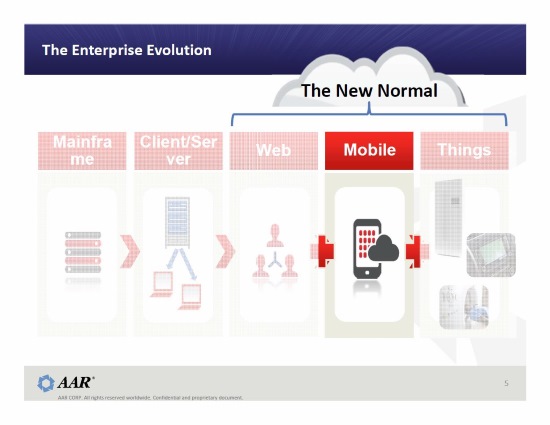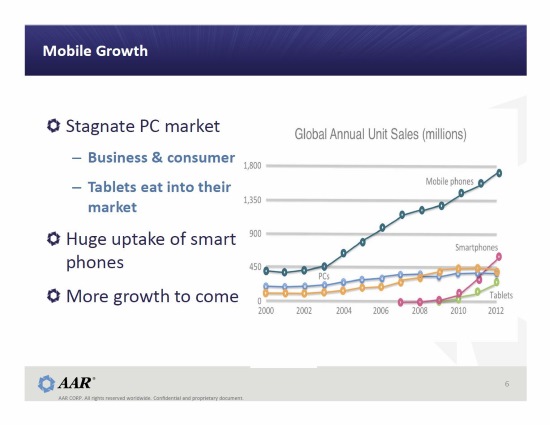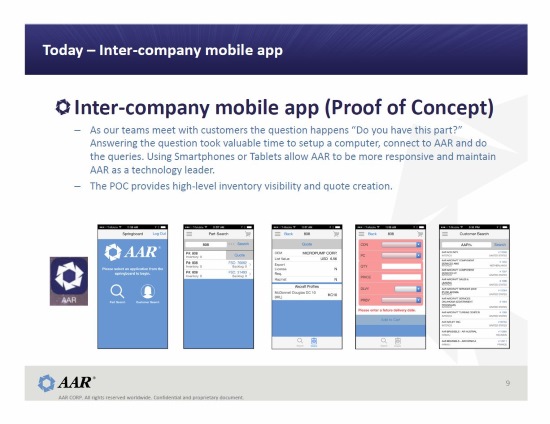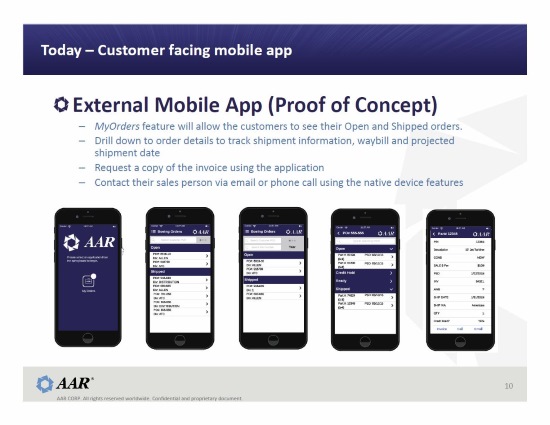Articles
| Name | Author | |
|---|---|---|
| Mobility solutions at AAR | Serdar Yorgancigil Director, IT Applications, AAR CORP | View article |
| Column: The World according to IT and me… Planning for retirement | View article | |
| It’s not always best to act early | View article | |
| Preparing for MRO IT System Implementation or change | View article |
Mobility solutions at AAR
Author: Serdar Yorgancigil Director, IT Applications, AAR CORP
SubscribeMobility solutions at AAR
Serdar Yorgancigil, Director, IT Applications at AAR, explains how the MRO business has adopted mobile solutions and how they have improved tracking and project management.
Mobile is the big story in Enterprise IT. This article will cover AAR’s customer-facing, integrated IT solutions around mobility solutions. However, before we get into the tools currently being used and developed at AAR, we will discuss some of our legacy MRO handheld applications, as well as the legacy supply chain handheld applications that AAR has been using for decades. Then, we will return to the present day and look at some recently completed and ongoing mobile application projects. We will also cover how to leverage off-the-shelf mobile applications – when appropriate – versus investing in custom mobile applications. And we’ll review the pros and cons of different mobile app development methods. Finally, we’ll discuss AAR’s roadmap for the next generation of mobile applications in the pipeline.
AAR’s 1MRO℠Software Suite manages all maintenance activities performed at the six aircraft maintenance locations in North America. 1MRO℠Software Suite includes the following modules:
- StAAR™: Strategic Tools by AAR;
Work card and labor tracking solution that manages and tracks every step of an aircraft MRO project, with controls for quality assurance. - IMOPS™: Inventory Management and Order Processing System;
Process‐oriented and event‐driven supply chain software. - APRISe™: AAR Performance Reporting Information System;
Safety Management System (SMS) integrity solution. - 1MRO℠ BI: Business Intelligence;
Oracle‐based performance reporting with effective metrics to reduce costs and ensure on‐time delivery. - OPS™: Online Partner Services;
Customer portal to check availability, approve ROs, view documentation.
Looking to the past
But first, a look back: Today, when we talk about mobile solutions, we immediately think of smart phones, tablets and devices that we carry in our pockets. At AAR, we have been providing mobile handheld solutions for our hangar and warehouse operations for nearly two decades. For hangar operations, we started back in 2005 using Symbol PDA’s by providing Discrepancy Management functionality to our inspectors. Then we extended this to Lead Mechanics with the Lead Evaluation application that allowed them to review and estimate work cards electronically. From the PDA’s we graduated to more capable Panasonic Toughbook devices to take advantage of the bigger screen size and better processing power. We also extended the functionality to include work card cycle count and inspection buyback features for our inspectors to review the buy-back requests made by technicians. For warehouse operations, we have been using Motorola scan guns for performing cycle counts, moving, picking and issuing parts since mid-90’s.
The world today
In the past, our solutions were driven by customer needs and that is still true today. What’s different now is that everything has to be even more accessible. As the image below shows, we started with mainframes and then moved to client servers before transitioning to the web. That has enabled a greater degree of mobility, which is what this article is about. And the newest development of all – 24-hour project access via the Internet – is already the new normal.

The graph below charts a trend with which readers will be familiar.

While the PC market is stagnant or falling, sales of mobile devices (phones, Smartphones and tablets) are skyrocketing. Those trends are expected to continue. So, it is becoming increasingly valued added to provide mobile solutions to our internal customers– technicians, inspectors, supervisors and warehouse personnel –, as well as our customers. The more mobility options we are able to give them, the more value we can add to their everyday responsibilities.
Mobile applications for the enterprise
Custom mobile application development strategies are not as well established for the enterprises and the B2B market as they are for the consumer market. There are different ways of doing custom mobile application development. According to a study published by Gartner in 2013, enterprise mobile application developments will be 10 percent native, 30 percent mobile web and 60 percent hybrid. It’s important to note that this doesn’t mean that one method is ‘wrong’ and the other one is ‘right’. The key point is to recognize the pros and cons of each method so that you can make an educated decision that will suit your needs best.
Native
Native applications reside and run on the device that they were developed for using the native development language of the device. As a result they are extremely well integrated with mobile device systems such as GPS, contacts, etc… and they respond very well to the single platforms for which they are designed. But if you need to consider the possibility of supporting multiple operation systems (iOS, Android, Windows) at some point, you will need to consider a development platform that can support your mobile application across multiple operating systems.
Mobile web
This is not really a mobile app; it’s a mobile friendly web site that has been optimized to be displayed on a mobile browser. These are fairly easy to develop and deploy, since you only need to ensure that your existing web application renders clearly on the mobile device’s browser. Noteworthy disadvantages are: It’s not very easy to integrate a mobile web app with device features and, more importantly, mobile web apps can’t work offline when there’s no internet connection to the web server hosting the application.
Hybrid
As the term suggests, hybrid is combination of native and mobile web methods. The application resides on the device and is installed from the app store just like a native application. The biggest difference is that the browser is embedded in the application that is installed on the device. So it’s possible to work with offline data storages. Furthermore, what makes it a truly attractive option for an enterprise environment is the fact that it allows cross platform development and deployment. Therefore, it’s possible to maintain one single source code. The applications developed using the hybrid method can be deployed on iOS, Android, Windows mobile and other operating systems as they may become relevant in the future.
Business Intelligence dashboard
At AAR, as we were looking at our business requirements, we evaluated our options and decided to go with the hybrid option. However, that doesn’t mean that every mobile application need has to be fulfilled with a custom application. There are scenarios where an off-the-shelf mobile application was the better solution for us. A good example of that is our Mobile Business Intelligence (BI) application.
About seven years ago, we rolled out BI Dashboards to provide real-time status of the maintenance activities at our hangars across multiple locations. The idea was to provide an overview of the status of the aircraft to AAR management as well as our customers so that they could track the status of a project without having to pick up the phone or drag files from various systems. It was a success, and soon thereafter our managers wanted to be able to access these dashboards on their mobile devices. At the same time, some of our MRO clients have requested access to the dashboards from their mobile devices so they can track the progress on their own aircraft.
By taking our existing Oracle BI dashboards and integrating them with Oracle’s Mobile BI application, which is available for iOS and Android platforms, we were able to deploy our existing dashboards and make them available as mobile dashboards with little additional development effort. Obviously, we had to make sure that there was an added level of security that guaranteed that each customer could only see their own projects. But as far as the content and data coming from our transactional systems, everything that worked for our BI solution worked perfectly well for us. This feature has been live since June 2014 with multiple customers’ on-site reps, as well as their off-site managers logging in daily to check the status of their projects.
Inter-company mobile application
As we were working on that project for the external BI initiative, we also started receiving requests from our internal users for a custom mobile application that would allow management and sales teams to answer some of the questions that they get from their customers about part availability. They might be at a business dinner or at home during after-hours during when logging on to a computer to access information is not always easy. Working with our business users and IT counterparts, we came up with the concept of an inter-company mobile application. This was our very first custom AAR mobile application. Since it’s an inter-company application, it’s not deployed on the app stores; we’re offering it from our inter-company app store. We had three primary goals in mind when we started working on this project.
First: Communicating with our existing LDAP Active Directory for user authentication so that we can extend our single sign-on application and make sure that we don’t have to deal with another set of userid/passwords
Second: Retrieving data from our existing back-end databases without re-designing the functionality that is used by our web applications.
Third: Collecting information on the mobile app and saving the data to the database using our existing API’s.

This application has been live since November 2014. Previously, when our sales teams met with customers and the question arose, “Do you have this part?”, providing an answer took valuable time to set up a computer, connect to AAR and submit an inquiry. Now our sales teams can look up a part number see its details and initiate a quote with a couple of clicks. Using the app on smartphones or tablets allows us to be more responsive and maintains AAR’s position as a technology leader.
Customer facing mobile app

Our next mobile project was to develop an external customer facing mobile app. This project is under way at the time of writing this but with completion expected by the publication date. Working with our customer sales reps and customer support staff, we identified a use case for a proof of concept project. This app will be available on Apple App Store and on Google Play. Customers will be able to log-in and see the status of their open orders, drill down into those orders to track shipment information, waybill and projected shipment date. One of the things that our customer service team members told us was that there are occasions when, during after hours, a customer (perhaps with a shipment held up at customs) might want a copy of the invoice; so we incorporated a ‘request invoice’ feature in this application. We’ve also integrated with the device features, allowing users to call or email their customer representative directly from the application.
That’s where we are today with our external BI, inter-company mobile app and external customer facing mobile app. But that isn’t all there is. We have a lot of good ideas in the pipeline.
Looking forward
We definitely want to expand on our inter-company mobile application with more details and capabilities such as:
- Inventory detail visibility;
- Ability to create a quote for a specific inventory item;
- Sales and quote history;
- Ability to choose the customer contact for quotes;
- Mobile warehouse; and
- Advanced Discrepancy and Non-Routine Management.
These are features that are already planned with existing back-end functionality.
We plan to replace the Motorola scan guns used at our warehouses with mini-tablets that connect to handheld cradles. This approach will maintain the ‘scan gun’ look and feel while allowing us to expand the available features on these devices. And lastly, we would like convert the handheld MRO applications currently running on the Panasonic Toughbook platform into the inter-company mobile application as well.
For the customer-facing application, short-term plans are to start incorporating some of the functions from AAR’s OPS customer portal into our mobile application. This will allow AAR’s customers to pick and choose the platform they want to use to access AAR based on their preference.
That’s how AAR has leveraged mobile solutions to improve internal workings, enhance the quality of support to technicians and management, add value to sales teams’ interactions with their customers, and empower customers to be able to access AAR’s systems to save them time and ensure they are up to date on the status of their project.
Contributor’s Details
Serdar Yorgancigil
Director, IT Applications
AAR CORP
Serdar joined AAR in 2007 as Director of IT at Aircraft Services – Oklahoma ; in 2009, he took a role with the MRO Group managing AAR’s custom MRO ERP system across all locations, providing integrated business system solutions as well as managing enhancements for the MRO ERP system. In 2014, Serdar transitioned from the MRO Group to Corporate IT and also became responsible for the mobile application development projects. He holds a BS in Computer Engineering.
AAR CORP
AAR is a global aviation services company that supports commercial, government and defense customers through two operating segments: Aviation Services and Expeditionary Services. AAR’s broad range of MRO and supply chain capabilities includes inventory management; parts supply; OEM parts distribution; aircraft maintenance, repair and overhaul; and component repair. AAR’s Expeditionary Services include airlift operations and mobility systems in support of military and humanitarian missions.
Comments (0)
There are currently no comments about this article.

To post a comment, please login or subscribe.